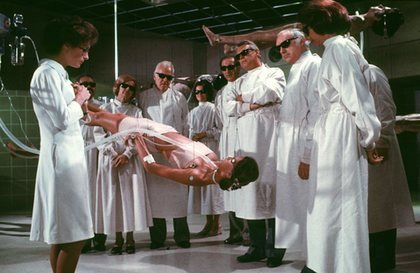The Austrian physiologist Eugen Steinbach began researching “reactivation,” his term for the process of making the aged young all over again, in the 1890s. He promoted the use of “brain extracts” for all and developed for men a type of vasectomy that would allegedly repurpose semen into an internal youth serum. It was bollocks, but the procedure still helped the doctor gain fame—if not the approval of his medical peers—because people rightfully fear death, a hideous and permanent condition. A 1941 report in the Brooklyn Daily Eagle marveled at how the 81-year-old, yet seemingly ageless, Steinbach was to go horseback riding on his birthday. What a remarkable specimen he’d turned himself into! He croaked three years later, however, like a mere commoner who’d been unenlightened about the bold ideas of educated men.
Today Alphabet aims to “cure death,” Libertarian putz Peter Thiel has vowed that HGH injections and other high-priced treatments will allow him to live to 140 (god help us all if so) and Singulatarian Ray Kurzweil pursues immortality by downing handfuls of supplements daily and working on a system to upload his brain into computers. Let’s hope for his sake it doesn’t wind up housed in Google Docs.
Don DeLillo’s 2016 novel, Zero K, takes on this fervor among the super-rich for an endless tomorrow: “We are born without choosing to be,” a character says. “Should we have to die in the same manner?” Well, we should search for better cures and longer lives, but there’s something creepy about the over-promising and narcissism of contemporary Silicon Valley immortalists who hope to escape societal collapse by fleeing to New Zealand and to outrun the Reaper through a combination of chemistry and computers. They talk about wanting to rescue the world, but they mostly want to save their own asses and stock options.
In “The History of the Future,” John Gray’s mixed New Statesman review of Peter J. Bowler’s forthcoming book about the hopes and fears provoked by what passes for progress, the critic examines the longstanding anti-death movement through Steinbach, Serge Voronoff and other historical crackpots, and interprets more technological utopias and dystopias that have sprung from laboratories and the humanities to fill our dreams and haunt our nightmares.
An excerpt about “enlightened” thought:
Many who have been optimistic about the possibilities opened up by technology have wanted to use it for purposes that would now be recognised as highly regressive; some of the most widely influential among these people have been renowned progressive thinkers. When a cult of technology is joined with fashionable ideas of human improvement, the upshot is very often gruesome inhumanity.
Consider eugenics. Writing of the interwar enthusiasm for policies that would “improve the human stock”, Bowler reminds us that exhibitions promoting Nazi eugenics and “racial hygiene” toured the US freely in the Thirties, while many American states enacted legislation for the compulsory sterilisation of people judged to be feeble-minded. For many progressives, eugenics was as quintessentially modern as town planning. Eugenic policies attracted the support of William Beveridge, John Maynard Keynes, Bertrand Russell and progressive luminaries throughout the world. In Sweden, the architect of the Scandinavian welfare state, Gunnar Myrdal, argued that a programme of mandatory sterilisation was necessary for social progress, with tens of thousands being subjected to the procedure up to the mid-Seventies.
Some in interwar Europe went so far as proposing the compulsory euthanasia of people classified as socially obstructive or useless. Bowler cites the French surgeon Alexis Carrell (1873-1944) as recommending that habitual criminals “should be humanely and economically disposed of in some euthanasia institutions supplied with proper gases”. Carrel was attacked for links with the Nazis, but policies of this kind were not confined to Nazis and their sympathisers. Carrell’s views were anticipated by George Bernard Shaw, whose long-time enthusiasm for involuntary euthanasia Bowler does not discuss.
In a speech to the Eugenics Education Society in 1910, Shaw declared: “A part of eugenic politics would finally land us in an extensive use of the lethal chamber. A great many people would have to be put out of existence simply because it wastes other people’s time looking after them.” Here Shaw was not speculating about a hypothetical future society. In his introduction to Sidney and Beatrice Webb’s English Prisons Under Local Government (1921), he explicitly advocated large-scale use of the lethal chamber as an alternative to imprisonment. In The Crime of Imprisonment(1946), he reiterated his view of how anti-social elements should be treated: “If they are not fit to live, kill them in a decent human way.”
Shaw’s belief that many human beings were “not fit to live” was a recurring theme among early-20th-century progressive thinkers. As Bowler notes, Wells looked forward to a future in which “The unfit would be painlessly eliminated, the mentally ill encouraged to suicide out of a sense of duty and the inferior races of the world would face extinction.” When in his non-fiction study Anticipations, first published in 1901, he considered the future of the “swarms of black and yellow and brown people who do not come into the needs of efficiency” in a scientifically ordered World State, Wells concluded that these and other “inefficient” human groups would have to disappear: “The world is not a charitable institution, and I take it they will have to go”. Here Wells was expressing a view of human progress that he never renounced.•

